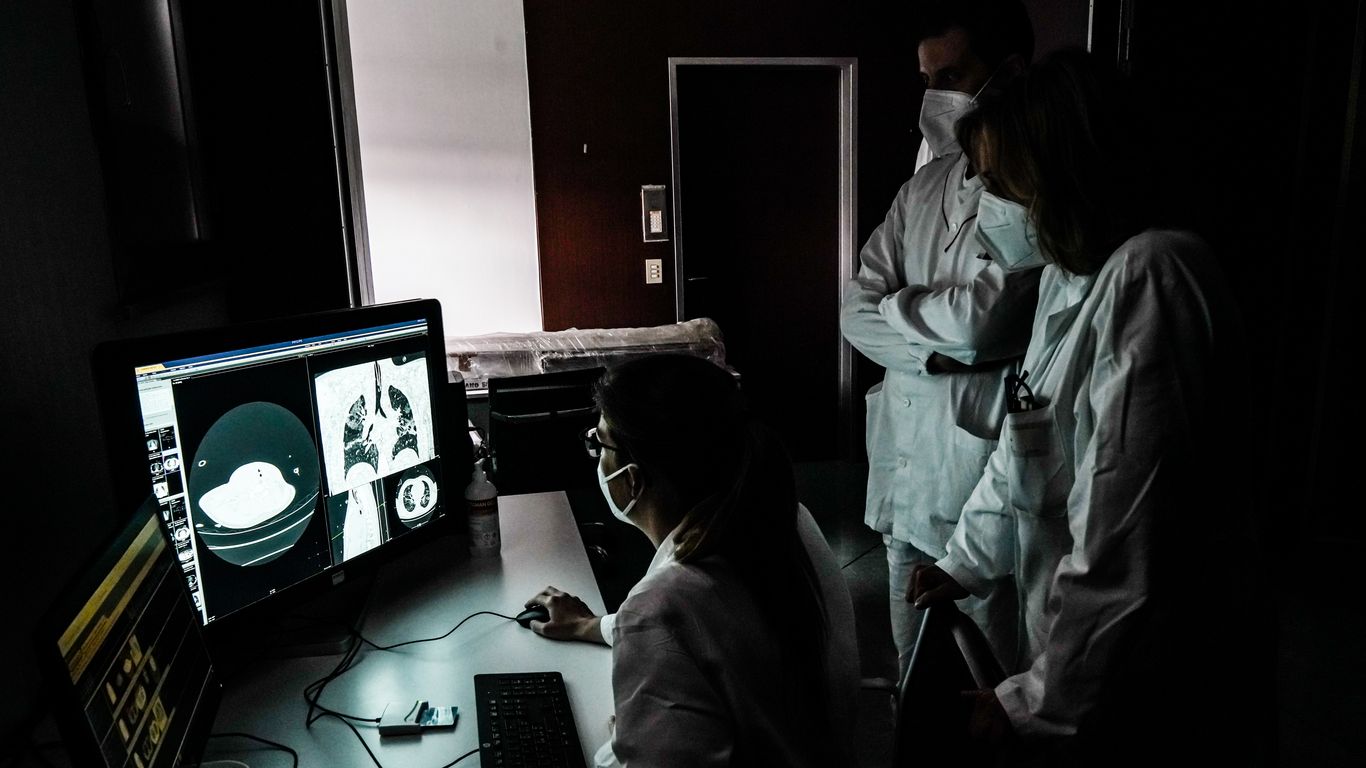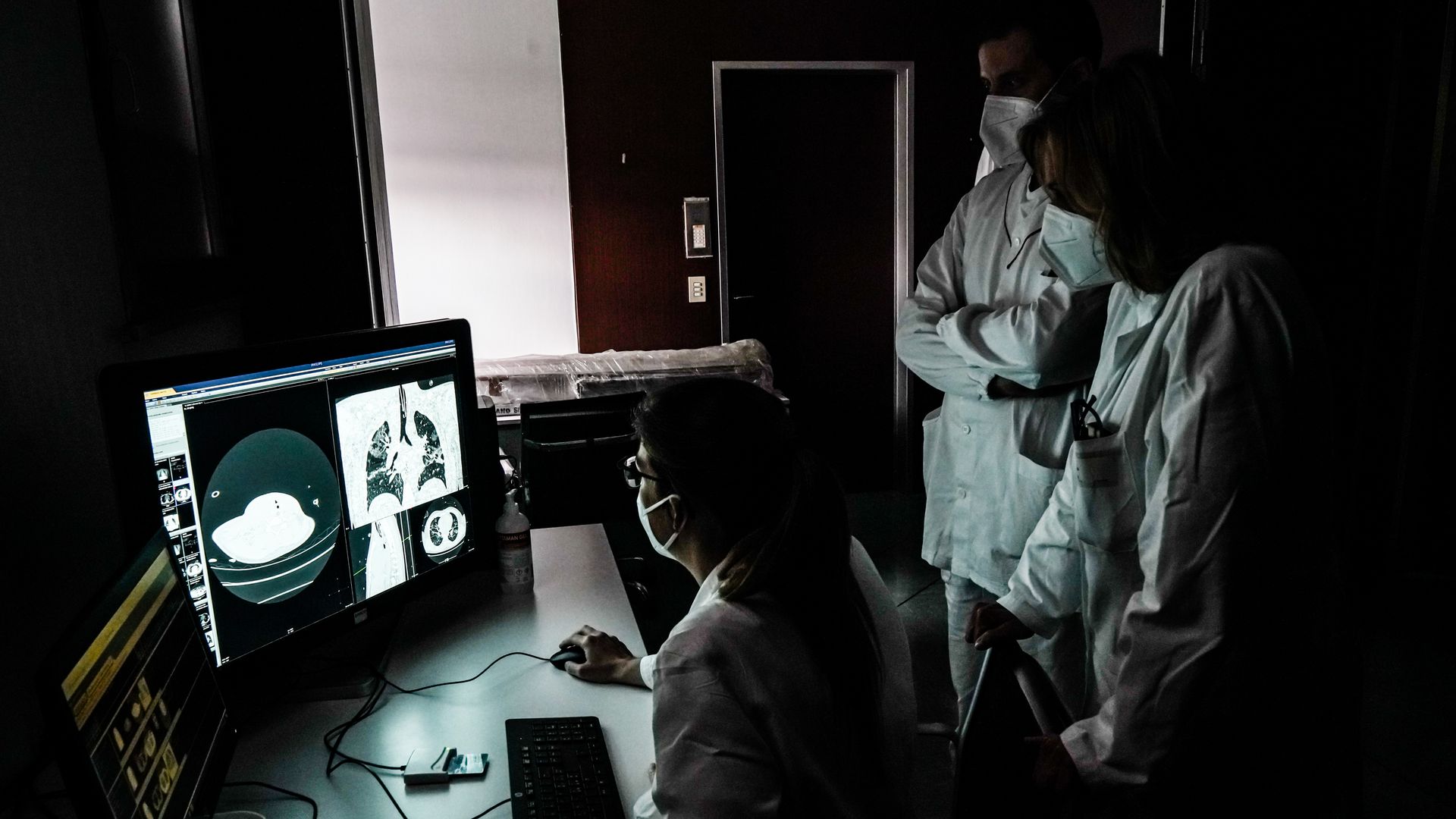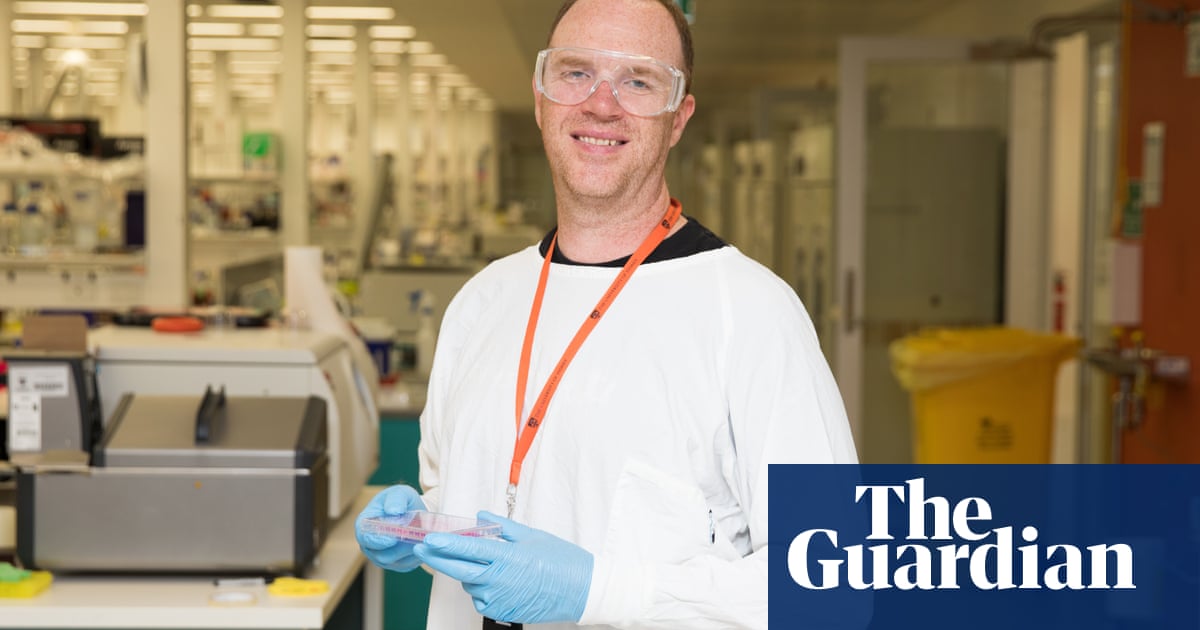Intestinal Fortitude
Have Faith

Australian researchers make "crazy interesting" discovery on blocking COVID infection
Researchers find protein in lungs that sticks to COVID virus like Velcro and forms a natural protective barrier against infection.
Australian researchers find protein in lung that blocks COVID infection

Radiologists in Cremona, Italy, observe CT scans of COVID-19 patients' lungs. Photo: Nicola Marfisi/AGF/Universal Images Group via Getty Images)
Australian scientists announced Friday they've discovered a protein in the lung that sticks to the COVID-19 virus like Velcro and forms a natural protective barrier in a person's body to block infection.
Why it matters: The study, published in the journal PLOS Biology on Friday, "opens up an entirely new area of immunology research" around this receptor protein, LRRC15, and "offers a promising pathway to develop new drugs to prevent viral infection from coronaviruses like COVID-19 or deal with fibrosis in the lungs," per a statement from the University of Sydney announcing their findings.
Left: A healthy control lung. Right: Immunofluorescent staining showing the newly discovered SARS-CoV-2 spike-receptor LRRC15 in green in post-mortem lung tissue of a person who died of COVID-19. Photo: Loo and Waller et al via the University of Sydney
- It could also help explain why some people who contract COVID experience serious illness, while others never get sick.
- The study builds on earlier research into the LRRC15 receptor. The new research shows that this naturally occurring protein can bind to the spike of SARS-CoV-2, the virus that causes COVID, and protect neighboring cells from infection, per an emailed statement from study lead author Greg Neely.
What they found: The researchers discovered that LRRC15 binds to the virus.
- Lipin Loo, a postdoctoral researcher who worked on the study with Neely, and Ph.D student Matthew Waller, noted in a statement that "it acts a bit like Velcro, molecular Velcro, in that it sticks to the spike of the virus and then pulls it away from the target cell types."
- LRRC15 can stick to the virus and immobilize it, preventing other vulnerable cells from becoming infected in the process.
- Waller said in a statement that the researchers "found that this receptor also controls antiviral responses, as well as fibrosis, and could link COVID-19 infection with lung fibrosis that occurs during long COVID."
What they're saying: "The LRRC15 protein appears to effectively mop up extracellular virus floating around in infected lungs," said Cassandra Berry, an immunology professor at Murdoch University in Western Australia, who was not involved in the study, in an emailed statement.
- "This discovery allows us to better understand innate immunity that helps to protect us during virus invasion and offers new ways for development of antivirals."
- "Since this receptor can block COVID-19 infection, and at the same time activate our body's anti-virus response, and suppress our body’s fibrosis response, this is a really important new gene."
Australian researchers find protein in lung that blocks COVID infection


Radiologists in Cremona, Italy, observe CT scans of COVID-19 patients' lungs. Photo: Nicola Marfisi/AGF/Universal Images Group via Getty Images)
Australian scientists announced Friday they've discovered a protein in the lung that sticks to the COVID-19 virus like Velcro and forms a natural protective barrier in a person's body to block infection.
Why it matters: The study, published in the journal PLOS Biology on Friday, "opens up an entirely new area of immunology research" around this receptor protein, LRRC15, and "offers a promising pathway to develop new drugs to prevent viral infection from coronaviruses like COVID-19 or deal with fibrosis in the lungs," per a statement from the University of Sydney announcing their findings.
Left: A healthy control lung. Right: Immunofluorescent staining showing the newly discovered SARS-CoV-2 spike-receptor LRRC15 in green in post-mortem lung tissue of a person who died of COVID-19. Photo: Loo and Waller et al via the University of Sydney- It could also help explain why some people who contract COVID experience serious illness, while others never get sick.
- The study builds on earlier research into the LRRC15 receptor. The new research shows that this naturally occurring protein can bind to the spike of SARS-CoV-2, the virus that causes COVID, and protect neighboring cells from infection, per an emailed statement from study lead author Greg Neely.
What they found: The researchers discovered that LRRC15 binds to the virus.- Lipin Loo, a postdoctoral researcher who worked on the study with Neely, and Ph.D student Matthew Waller, noted in a statement that "it acts a bit like Velcro, molecular Velcro, in that it sticks to the spike of the virus and then pulls it away from the target cell types."
- LRRC15 can stick to the virus and immobilize it, preventing other vulnerable cells from becoming infected in the process.
- Waller said in a statement that the researchers "found that this receptor also controls antiviral responses, as well as fibrosis, and could link COVID-19 infection with lung fibrosis that occurs during long COVID."
What they're saying: "The LRRC15 protein appears to effectively mop up extracellular virus floating around in infected lungs," said Cassandra Berry, an immunology professor at Murdoch University in Western Australia, who was not involved in the study, in an emailed statement.- "This discovery allows us to better understand innate immunity that helps to protect us during virus invasion and offers new ways for development of antivirals."
- "Since this receptor can block COVID-19 infection, and at the same time activate our body's anti-virus response, and suppress our body’s fibrosis response, this is a really important new gene."





